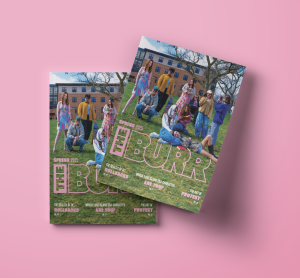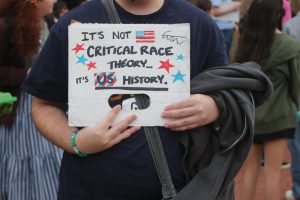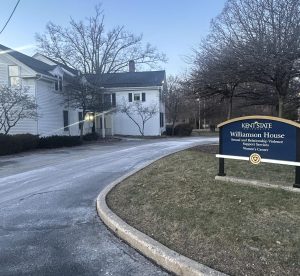Written by Augusta Battoclette for Spring 2020 print issue of The Burr Magazine
Sandra Scheuer. When most people hear her name, they think of May 4, 1970. They think of how she and three others were killed by the Ohio National Guardsmen after they opened fire on unarmed Kent State University students. But, to my grandma, who was a senior speech therapy student in 1970, Sandra was just her young, bright and bubbly 20-year-old classmate at Kent State.
SANDRA
Sandra, nicknamed Sandy, grew up in Boardman, a suburb of Youngstown, Ohio. Her father, Martin Scheuer, fled to Palestine from Nazi Germany as Hitler rose to power, arriving in Youngstown in 1937. Before Sandy was killed, her father supported President Nixon. “I would read the Youngstown newspaper and believe what he said was right,” he told Joe Eszterhas in the book “Thirteen Seconds: Confrontation at Kent State.” “I voted for Nixon,” he said, “but all that has changed since her death. Yes, I have changed. Today I am against American presence any place in the world.”
In 1968, Sandy was a sophomore living in Tri-Towers. “She had jet-black hair, a freckled nose and a contagious laugh,” Peter Jedick says. Jedick is a journalist who has written for the Plain Dealer, Cleveland magazine, Sun Newspapers and a collection of other publications. Also a Kent State student in 1968, he was in the food line next to Sandy and her friend Sharon Swanson in the Tri-Towers dining hall one day. They invited him to sit with them.
“She sat smiling and laughing at the table, making offbeat comments about the school, the city and the other students, while saying, ‘Hi,’ to many friends as they passed by,” he tells me. Jedick told Sandy and Sharon about a Lou Rawls concert at Bowling Green State University he attended the previous weekend. “By the end of lunch, we were instant friends and she was calling me Lou.”
***
AUGUSTA
All my life people have told me they love my name, Augusta. Whenever I wear my badge at work, people always comment on how unique and pretty my name is and ask if my parents named me after someone. The short answer is yes — my grandmother. The long answer is that my name is one of the best gifts I have ever received. While I have the same name as my grandma, I share it with a whole line of my family, going back several generations, alternating genders each time. My dad was named August, my grandma was named Augusta, my great-grandfather was named Agustino and my great-great-grandmother was named Agustina. The name has become more modernized with each generation, but the sentiment remains the same. I am forever connected to my family — and my heritage — through my name.
My grandma, Augusta Tortorice Battoclette, was an outspoken and opinionated, but loving Italian woman who made the best lasagna in the world. “Gussie,” as she was called, loved art, specifically painting with watercolors. Gussie married her husband, my grandpa James Battoclette, in 1950. They were married for 68 years before she passed away in the summer of 2018. I was fortunate to interview her about her May 4 experience for a school project before she died.
Given that she was already married and had four kids when she started at Kent State, Gussie was a nontraditional student. My grandpa earned his master’s degree at Kent State and later went on to earn his Ph.D. at Ohio State University. In the 1970s, he was a professor at the Kent State University School (KSUS), a laboratory school for elementary through high school students. There, education major college students were able to get classroom experience through observation, participation and student teaching.
All four of their kids attended KSUS and the two oldest, Maryann and Mike, had their father as their sixth-grade teacher. Since Kent State was initially established as a teaching college, KSUS was originally a teacher training school when it opened in 1913. It later evolved into a lab school in tandem with the College of Education. Merrill Hall, the first building built on campus, was the initial place that housed KSUS. Soon after, in 1916, it moved to Kent Hall, then to Franklin Hall before finally settling in the Schwartz Center (built specifically for KSUS and originally called the University School) in 1956. Even though KSUS closed in 1972 after enrollment dropped following the May 4 shootings, you can still walk through the Schwartz Center and see aspects of its architectural design that are reminiscent of a school building.
***
After Sandy’s death, her parents urged Kent State president Robert White to write a letter to the Youngstown newspaper The Vindicator to clear up rumors that Sandy was a bad student, had been arrested three times, sold drugs and stirred up the kids, all of which were false, according to Eszterhas. White wrote that Sandy was never “cited by KSU security officers, the Kent city police or any other law enforcement officers.”
Sandy was quite the opposite of what the rumors claimed. She was a people person, involved in Greek life and if you walked with her to class you would witness her waving to everyone. She had all kinds of friends, from straight-laced, conventional students to hippies with shoulder-length hair.
Jedick wishes he could have been closer to Sandy. “She was just a really fun person,” he says. “I always kicked myself that I didn’t ask her out. She just knew everybody, really outgoing.”
Sandy befriended Gussie, who was twice her age, after they had class together in 1970. “We used to sit together in class,” Gussie said. “She was just an ordinary college kid filled with pep.” They were in a lip-reading class and often had to identify what their teacher was saying only by reading her lips. “I could not understand the lip readers one bit! Sandra would whisper, ‘I know what this is,’ and she would tell me what the answer was. I just liked her a whole lot.”
Sandy was a speech therapy major just like Gussie and was particularly interested in helping older people who had difficulty talking or were paralyzed. “Sandy used to say she wouldn’t have the heart to charge people $10 or $15 an hour for speech therapy,” her mother, Sarah, told Eszterhas. While Sandy loved traveling, playing tennis and swimming, her main interest was her studies, and she often worried that her B-plus grades weren’t good enough. She grew up in a deeply religious, work-oriented family with strong values and did not want her scholarship to suffer by not doing well in school.
The weekend before Monday, May 4, Sandy was supposed to be in Atlantic City with her roommate who was looking for a summer job. However, she didn’t go because she would have had to miss her Monday classes, something she was unwilling to do. She and her friend Sharon, also a speech therapy major, had to start working on a paper that week about organic speech disorders and cerebral palsy. If she had gone to Atlantic City she would not have been in Kent on May 4.
***
The Battoclette family home was about a half-mile from campus, situated between grassy fields and apartment buildings for married students. The street is now located behind Fraternity Circle in the neighborhood near where Allerton meets Campus Center Drive. On May 1, the day after President Nixon announced he was extending the Vietnam War by sending troops into Cambodia, Gussie and her family could hear the roars of protesters in downtown Kent all the way from the house. “Other students were protesting around the country, but at Kent [State] it got out of hand,” Gussie said. “Especially when Nixon announced he was going to start bombing Cambodia. Then the mayor became concerned and (the governor) called in the National Guard, which was a big mistake in my mind.” When the ROTC building on campus was set on fire, they could see from their house the smoke rising into the sky and flames licking the top of the building.
“The Guard came into town that evening,” my aunt MaryAnn, a sophomore at KSUS at the time, says. “I was babysitting down the street from our house and the mother of the children called my parents frantically as the Guard marched through the neighborhood.”
A petition was sent around saying that the mayor was within his rights to call the National Guard. “I refused to sign because I thought that was unconscionable,” Gussie said.
On May 4, all four of Gussie’s kids, MaryAnn, Mike, Renee and August, went to school as usual, despite the abnormality of the entire situation. A bomb threat was called into KSUS, but later was found to be a result of fear-mongering. It was controlled chaos. “We started hearing a lot of rumors,” MaryAnn remembers. “We heard there was gunfire, but nobody knew exactly what was going on. There were supposedly snipers on the buildings across the street. We had heard that one Guard member had been stoned.”
Mike’s teacher shut all the blinds in his classroom and told everyone to get away from the windows and not look out. “Some of my buddies crawled on the floor to peek out the windows,” he says. They were let out of school early and had to wait for my Grandpa to finish making sure all the students were safely picked up by their parents.
***
Sandy and Sharon met on Monday morning for their 8:30 a.m. childhood art class, Eszterhas wrote. Then they went their separate ways before their next class together at 1:30 p.m. They ran into each other a bit later and Sharon asked Sandy if she was actually going to go to class with all the protesting going on. Sandy said she would be there. As she walked out of the Commons, Sandy waved to a friend on the terrace in front of Taylor Hall just as the National Guard reached the top of the hill and turned around.
***
Earlier that day, Gussie was headed to campus for her 7:45 a.m. class but was told by other students to go back home, that it was not safe. Students were gathered at the Commons, some protesting, some observing. Her friends complained about the National Guard occupying campus. “I said, ‘But they’re there for your protection!’” she recalled. “They told me, ‘No, Gussie, they are hurting our students.’”
Gussie followed the advice of her friends and went home that morning.
Later, she found out that there were four dead. Hearing their names shocked her. One was Sandy. Her classmate. Her friend, shot by a stray National Guard bullet from afar as she crossed the parking lot near Taylor Hall. She was hit in the throat. “She was going to be a speech therapist,” Gussie said.
Sandra was not protesting, she was just walking to class. Gussie was not protesting, either. These two women, similar to each other in many ways, were both bystanders at an ill-fated event. Neither knew what would happen that Monday or how that day would forever change the world.
That night the town was under a curfew. Most of the students who did not live in Kent went home. The night was deathly quiet. The only sounds were the occasional helicopter flying overhead, military vehicles driving around town and some pops — the family assumed they were gunshots. In the middle of the night, a barn on Allerton caught fire. The National Guard was using KSUS as a staging area. The eerie nights and curfew continued for a week.
The university was closed for about six weeks and Gussie’s graduation was delayed. Mike and his friends would go down to the football and baseball fields to play around during the day since they didn’t have school. The National Guard’s helicopters would sometimes land on the field while they were there. Mike would run up to the Guardsmen and talk to them, even though the children were told to be careful. “Before May 4, a lot of us would often go up to campus, to the Hub and the library,” MaryAnn says. “This was frowned upon before but strictly forbidden after.”
***
Because of my family’s close connection to Kent State, I learned about the shootings long before I applied to the school. When I began applying to colleges, I was especially interested in Kent State and Ohio University, as both have impressive journalism schools. Both offered similar programs, extracurriculars and classes, but ultimately choosing Kent State was choosing a school where I was a legacy and where there was an intense history linked to my family.
Now, wrapping up the end of my third year at Kent State and with the 50th anniversary quickly approaching, I find myself reflecting on both Sandy and Gussie’s stories and how simple choices can change the course of future generations. Sandy never got the chance to have children and grandchildren of her own, but I am lucky that I get to carry on my family name.
And while many current Kent State students do not have a personal connection to the May 4 events, it is good for them to hear these stories and learn about the impact the shootings had on people, like Gussie and her family.
“I know what it’s like to live under martial law, and it was scary,” MaryAnn says. “I remember it vividly, and it will always have a lasting effect. I can’t believe it has been 50 years.”












